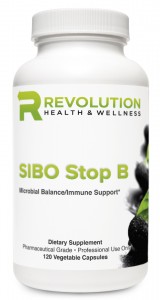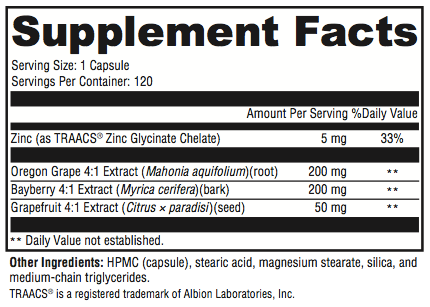SIBO Stop B

Berberis aquifolium (Oregon grape) – Berberine is a plant alkaloid derived from a variety of herbs, including Oregon grape root. This phytochemical constituent has a long history of use in Chinese and Ayurvedic medicine owing to its effectiveness and safety. Berberine extracts have demonstrated significant ability to influence the activity of a variety of organisms that affect human health.[1-3] Mechanisms of action may include effects on organism adhesion and intracellular invasion, metabolic activity, maturation, and enterotoxin formation.[1,4] Berberine can also address the intestinal secretion of water and electrolytes induced by certain organism toxins, thereby supporting healthy stool formation.[1] Furthermore, it may reduce smooth muscle contraction and intestinal motility, and delay intestinal transit time. Both in vitro and animal research suggest that berberine can affect COX-2 protein.*[1]
Myrica cerifera (bayberry) – The root bark and berry of bayberry have been traditionally used as an astringent and circulatory stimulant. Like the berry, the root bark contains tannin constituents that are responsible for its astringent action.[5,6] Astringent herbs are traditionally used to maintain the already normal release or secretion of perspiration, stool, essence (the body’s reproductive and regenerative substance), and urine. As a circulatory stimulant, bayberry helps to increase body energy levels and supports toxin elimination. Myricitin, a flavonoid isolated from bayberry, exhibits antioxidant activity, particularly in the colon.*[7]
Citrus x paradisi (grapefruit) – The seed extract of grapefruit, commonly known as GSE, is widely used as an oral supplement to maintain healthy gut ecology. GSE is employed by the food processing and agricultural industries for a diversity of applications. It is important to note that GSE contains a variety of phenolic substances with antioxidant activity including vitamin C, hesperidin, limonoids, tocopherols, serols, citric acid, and other trace minerals.*[8,9]
Zinc – The supportive effects of zinc on immunity and microbial balance are well documented.[10,11] Zinc ions are thought to work directly in the GI tract, affecting microbial activity therein. Immune cells, due to their high rate of proliferation and differentiation, need a constant and sufficient supply of zinc. Although further study is needed, zinc supplementation also shows promise in its ability to support healthy stool formation. In this formula, zinc is provided as Albion® TRAACS® zinc glycinate chelate for optimal absorption and utilization.*
Directions
Take 1 capsule daily (unless otherwise directed).
References
- Vuddanda PR, Chakraborty S, Singh S. Berberine: a potential phytochemical with multispectrum therapeutic activities. Expert Opin Investig Drugs. 2010 Oct;19(10):1297-307. [PMID: 20836620]
- Yu HH, Kim KJ, Cha JD, et al. Antimicrobial activity of berberine alone and in combination with ampicillin or oxacillin against methicillin- resistant Staphylococcus aureus. J Med Food. 2005 Winter;8(4):454-61. [PMID: 16379555]
- Rohrer U, Kunz EM, Lenkeit K, et al. Antimicrobial activity of Mahonia aquifolium and two of its alkaloids against oral bacteria. Schweiz Monatsschr Zahnmed. 2007;117(11):1126-31. [PMID: 18072463]
- Saha P, Bhattacharjee S, Sarkar A, et al. Berberine chloride mediates its anti-leishmanial activity via differential regulation of the mitogen activated protein kinase pathway in macrophages. PloS One. 2011 Apr 5;6(4):e18467. [PMID: 21483684]
- Myrica cerifera. Withlacoochee Permaculture Guild. http://wcpermaculture.org/plants/myrica-cerifera. Accessed August 2, 2011.
- Grieve M. Bayberry. A Modern Herbal. Botanical.com. http://botanical.com/botanical/mgmh/b/bayber20.html. Accessed August 2, 2011.
- Asano N, Kuno T, Hirose Y, et al. Preventive effects of a flavonoid myricitrin on the formation of azoxymethane-induced premalignant lesions in colons of rats. Asian Pac J Cancer Prev. 2007 Jan-Mar;8(1):73-76. [PMID: 17477776]
- Jayaprakasha GK, Girennavar B, Patil BS. Radical scavenging activities of Rio Red grapefruits and Sour orange fruit extracts in different in vitro model systems. Bioresour Technol. 2008 Jul;99(10):4484-94. [PMID: 17935981]
- Manthey JA. Biological properties of flavonoids pertaining to inflammation. Microcirculation. 2000;7(6 Pt 2):S29-34. [PMID: 11151968]
- Puertollano MA, Puertollano E, de Cienfuegos GÁ, et al. Dietary antioxidants: immunity and host defense. Curr Top Med Chem. 2011;11(14):1752-66. [PMID: 21506934]
- Knoell DL, Liu MJ. Impact of zinc metabolism on innate immune function in the setting of sepsis. Int J Vitam Nutr Res. 2010 Oct;80(4- 5):271-77. [PMID: 21462110]








